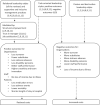Relationships between nursing leadership and organizational, staff and patient outcomes: A systematic review of reviews
- PMID: 37306328
- PMCID: PMC10415995
- DOI: 10.1002/nop2.1876
Relationships between nursing leadership and organizational, staff and patient outcomes: A systematic review of reviews
Abstract
Aim: To assess and describe reviews of nursing leadership styles associated with organizational, staff and patient outcomes.
Design: A systematic review of reviews.
Methods: Reviews describing a search strategy and quality assessment. The review followed the PRISMA statement. Nine databases were searched in February 2022.
Results: After screening 6992 records, 12 reviews were included reporting 85 outcomes for 17 relational, nine task-oriented, five passive and five destructive leadership styles. Transformational leadership, which is one of the relational styles, was the most studied among all the styles. Of the outcomes, staff outcomes were the most reported, notably job satisfaction, and patient outcomes were less reported. Also, mediating factors between relational leadership styles and staff and patient outcomes were identified.
Conclusion: Extensive research shows the beneficial impacts of relational leadership; however, destructive leadership research is lacking. Relational leadership styles should be conceptually assessed. More research is needed on how nurse leadership affects patients and organizations.
Keywords: nurse outcomes; nurse-sensitive outcomes; nursing management and leadership; nursing staff; organizational outcomes; patient outcomes; systematic review; umbrella review.
© 2023 The Authors. Nursing Open published by John Wiley & Sons Ltd.
Conflict of interest statement
None.
Figures
References
-
- Aromataris, E. , Fernandez, R. , Godfrey, C. M. , Holly, C. , Khalil, H. , & Tungpunkom, P. (2015). Summarizing systematic reviews: Methodological development, conduct and reporting of an umbrella review approach. International Journal of Evidence‐Based Healthcare, 13(3), 132–140. 10.1097/XEB.0000000000000055 - DOI - PubMed
Publication types
MeSH terms
LinkOut - more resources
Full Text Sources



